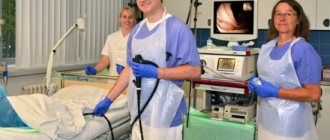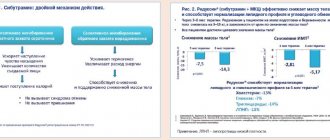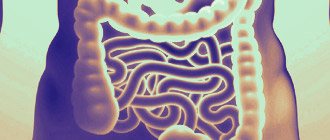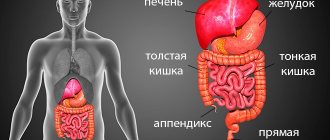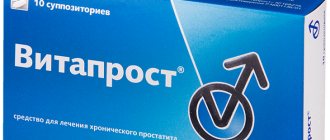Anesthesia is widely used not only when performing medical procedures, but can also be provided in conjunction with diagnostic measures. The use of painkillers is possible during an endoscopic examination of the colon.
There are several options to help ease the patient's experience during a colonoscopy:
- Use of local anesthetics.
- Medication-induced sleep (sedation).
- General anesthesia.
general information
Colonoscopy with sedation is one of the modern research methods aimed at studying the internal state of the intestinal walls using a special device equipped with a camera, which is inserted through the anus. All information is displayed in the form of a detailed picture on the display, thanks to which the doctor can draw up a detailed clinical picture of the patient’s health status and diagnose many gastrointestinal diseases of various origins in the early stages of development.
It is worth noting that this research method is used not only to make an accurate diagnosis, but also to take soft tissue samples for analysis, eliminate internal bleeding, treat intestinal obstruction and perform surgery to remove polyps and tumors. Thus, the scope of application of colonoscopy with sedation (reviews about the procedure are mostly positive) is quite wide. This research method is used everywhere when any gastrointestinal diseases are suspected.
Conducting an examination under anesthesia has many strengths. The person is calm and completely relaxed. And some medications used for anesthesia cause short-term amnesia, so the patient will not remember any unpleasant moments.
What is an intestinal colonoscopy under anesthesia?
Colonoscopy is a radical invasive method of medical examination of the gastrointestinal tract.
During the procedure, the doctor uses special equipment (a device connected to a computer) and slowly, millimeter by millimeter, inserts a thin hose deep into the intestine through the anus, which transmits images of the inner surface of the intestine to the monitor. The use of the method began in 1963. In Russia, this type of examination began to be used since the end of the last century. Initially, the diagnosis was done without anesthesia, as a result of which some patients were unable to bear the pain, they experienced muscle spasms, psychological balance was disturbed, and the examination had to be suspended.
Types of procedure
There are several methods for performing a colonoscopy.
- Virtual - information is collected using CT and MRI. Both laboratory research methods are innovative and are highly accurate and informative. This option is the most preferable because it is completely painless and has almost no contraindications or side effects.
- Using an endoscope, a special device is inserted into the intestines through the anus, which is a two-meter long tube, at one end of which there is a video camera that displays the image on the display.
In the latter case, the patient is sedated before the colonoscopy. This is a mandatory condition, since the procedure causes severe discomfort and pain to the person, so it is simply impossible to endure it without anesthesia.
Colonoscopy using anesthesia: pros and cons
Like any medical intervention, research using anesthesia has two sides.
Advantages of performing the procedure under anesthesia:
- Relief of anxiety before the study is achieved by administering sedatives;
- painless intervention due to the administration of analgesics;
- reduction of examination time - when a person is relaxed, the intervention takes place without delay.
Minuses:
- Possible adverse reactions to anesthesia drugs;
- higher cost;
- If the study is carried out on an outpatient basis, then it is necessary to find an accompanying person. This person should help you get home after the procedure.
Indications for use
This aspect deserves special attention. For older people who do not have a genetic predisposition to colon cancer, it is recommended to have a colonoscopy with sedation at least once every five years. If a person has had relatives in their family who have had problems with cancer, then it is advisable to undergo examination every 12 months. This is necessary for timely diagnosis of the disease and initiation of treatment. In addition, the following health problems can also be identified among the indications for use:
- suspicion of internal bleeding in the large intestine;
- benign and malignant formations;
- body temperature 37-37.5 degrees, which lasts for a long period of time;
- sudden and unjustified loss of body weight;
- chronic digestive disorder;
- anemia;
- chronic inflammation of the gastrointestinal tract, occurring in acute form;
- ulcerative colitis.
If you decide to undergo an examination, then you need to take into account that this procedure also has some contraindications. Sedation during colonoscopy is not recommended during pregnancy, with pulmonary and heart failure, peritonitis, ulcerative colitis, poor blood clotting, allergic reactions, as well as any pathologies of infectious etiology.
Features of the procedure in children
To examine children, only colonoscopy is used without pain, that is, under general anesthesia. This is due to the fact that the examination can cause quite serious psychological trauma in the child. Moreover, the discomfort when inserting a colonoscope tube into the rectum and while introducing air into the intestines may seem unbearable to a small patient.
The sequence of actions does not differ from the standard ones, but children still have some peculiarities:
- the doctor needs to establish a trusting relationship with the patient, reassure him and, if possible, tell him more about the goals and results of the examination;
- the dose of anesthesia is calculated so that it is sufficient only for the duration of the procedure;
- air is supplied into the intestinal lumen in smaller volumes than in adult patients;
- After the examination, the child’s condition is closely monitored for several hours.
Important! Diagnosis of colon diseases using this method and under anesthesia in children is trusted only to highly qualified specialists with extensive experience.
Since the baby's intestines are thinner, the doctor will have to act with extreme caution. Therefore, diagnosis will take slightly longer than in adults. On average, it takes 30 to 45 minutes to examine a child's colon. After the examination is completed, the anesthesiologist wakes the child and assesses his current condition.
Preparing for the examination
Colonoscopy under sedation, reviews from patients and doctors fully confirm this, it is highly accurate and informative. However, in order to reduce the likelihood of a false diagnosis, it is necessary to first prepare your body for the procedure. In approximately 3-4 days, you need to eliminate the following foods from your diet:
- cow's milk;
- soda;
- black tea and coffee;
- alcohol;
- pasta;
- any pastries;
- wheat cereal;
- fruits and vegetables;
- legumes;
- nuts;
- fatty foods;
- smoked meats;
- sausages;
- semi-finished products;
- products that contain dyes, preservatives and flavor enhancers.
It is best to stick to proper nutrition. It is recommended to include the following products in the menu:
- natural yoghurts;
- dairy products;
- boiled turkey meat;
- steamed sea fish;
- chicken bouillon.
If you decide to have a colonoscopy with sedation, you need to take it very seriously. Consumption of the products listed above may negatively affect the accuracy of the examination and make it difficult for doctors to make the correct diagnosis. The last meal should be consumed no later than 12 hours before the expected visit to the doctor. During this time, drinking pure water without gas and green tea is allowed. 2 hours before the start of the procedure, it is forbidden to even drink, since the stomach must be empty.
Other preparatory measures are discussed with the doctor individually. In most cases, patients are prescribed bowel cleansing through an enema or taking medications that have a laxative effect, such as Lavacol or Fortrans. The dosage is calculated by the doctor for each patient separately, taking into account body weight and a number of other factors.
How is the procedure performed?
Many people scheduled for a colonoscopy with sedation are afraid to go to the hospital because they have no idea how it works. But there is nothing wrong with this method of laboratory research. Everything happens according to the following scheme:
- The patient takes a lying position on the left side on the couch, pressing his legs with his knees to his stomach.
- The specialist performs complex anesthesia. It may involve general anesthesia, taking sedatives, or lubricating the anus with a special gel containing an anesthetic.
- Once the anesthesia begins to take effect, a probe is inserted into the anus.
- Depending on the specific purpose of the study, the duration of the procedure can range from 15 minutes to the complete completion of all necessary manipulations by the doctor.
- The colonoscope is brought out from the colon.
It is worth noting that during colonoscopy, anesthesia, sedation or other anesthesia methods are performed only in the presence of a qualified specialist. This is necessary not only to calculate the correct dosage, but also to minimize any risks that may pose a threat to the patient's health.
Algorithm
Let's look at this aspect in more detail. A colonoscopy with medicated sleep is performed as follows:
- the patient sits on the couch;
- the anesthesiologist measures blood pressure and examines the patient;
- the patient is asked to lie on his side with his legs pressed to his stomach, his knees should be at chin level;
- After this, the patient is given an anesthetic and an oxygen mask is put on.
When the painkiller begins to take effect, the manipulation itself is performed. You should first treat the anus with an antiseptic composition. After this, the tip of the endoscope is inserted into the rectal canal. The device is gradually placed into the intestinal space, while conducting a detailed examination of the mucous membranes. The client's position can be changed if necessary. After completion of the examination, the patient is transferred to the ward for awakening and recovery. It will take the patient some time to come to his senses. But the next day there will be no trace of anesthesia.
A few words about anesthesia
Colonoscopy is a very unpleasant examination method associated with some discomfort, and in some cases even severe pain. Therefore, it is performed under anesthesia. The following options exist:
- General anesthesia. A person is injected intravenously with a drug that puts him into deep sleep. After the effect of the medication ends, the patient gradually comes to his senses, not remembering anything and without experiencing any discomfort.
- Local anesthesia. The device is lubricated with a special gel before insertion into the intestine. In this case, the pain does not disappear anywhere, but the advancement of the probe becomes almost imperceptible.
- Colonoscopy with sedation. This is the most common pain relief option. It is similar to medicated sleep, but the person is conscious, feeling nothing at all.
The specialist decides which type of anesthesia will be used during the examination based on the patient’s health condition.
Progress of the operation
During the examination under anesthesia, the manipulations and their sequence are the same as doing a colonoscopy without anesthesia. The only difference is the injection of sedatives or other drugs, which is given immediately at the beginning of the procedure. After the patient falls asleep, the examination begins, and the anesthesiologist monitors the patient’s condition.
The patient is placed in a position that will allow free access to the anus. To do this, lay him on his left side with his knees slightly bent. The doctor lubricates the end of the colonoscope tube with a special gel and inserts it into the rectum.
To advance the tube and provide a good view, carbon dioxide is pumped into the intestines in small portions. The doctor examines the intestinal mucosa and moves the colonoscope further, again introducing carbon dioxide. If benign tumors are found on the intestinal walls, the doctor uses a loop to remove them, and then special forceps to extract the tissue out. Later they will be examined for the risk of their degeneration into cancerous tumors.
Important! Timely excision of polyps prevents them from gradually malignizing (degenerating into cancer), and also prevents hidden intestinal bleeding.
On average, a colonoscopy procedure with anesthesia lasts about 20-30 minutes. At the end of the procedure, the anesthesiologist wakes up the patient. The results of intestinal diagnostics are recorded by an endoscopist and transferred to a gastroenterologist or coloproctologist.
Advantages and disadvantages of sedation
General anesthesia is used very rarely, since complete immersion of the patient in a state of sleep requires a long recovery of the body. As practice shows, in the vast majority of cases, sedation is prescribed during colonoscopy. This option is considered one of the most optimal. Among its main advantages are the following:
- absence of discomfort, pain, as well as feelings of anxiety and fear;
- the possibility of non-surgical removal of tumors;
- elimination of bleeding in the colon;
- the possibility of performing the procedure on patients of any age category;
- completely relaxes the patient and reduces the risk of damage to the intestinal mucosa;
- helps a person cope with fear of the procedure and stress.
Despite many advantages, colonoscopy with sedation during sleep also has a number of disadvantages. These include:
- the likelihood of developing side effects from administered medications;
- intoxication of the liver and kidneys;
- memory problems.
Modern medications used for anesthesia during gastrointestinal examinations have a unique chemical composition and are safe for the body. They cause almost no side effects or serious consequences for the patient's health. Intravenous sedation during colonoscopy is considered one of the safest. This anesthesia begins to act quickly, and recovery from it does not take much time.
Restrictions
Colonoscopy under sedation (reviews of this procedure are more positive than negative) is one of the most gentle and harmless methods for studying the state of the gastrointestinal tract. However, this type of anesthesia cannot be used in all cases. The main contraindications include:
- children under 12 years of age;
- the presence of adhesions in the intestines;
- nasal congestion;
- epilepsy;
- peritonitis;
- sensitivity;
- low pain threshold;
- individual intolerance to the drug;
- the presence of allergic reactions;
- stenosis of the intestine or anus;
- non-compliance with the prescribed diet;
- mental disorders;
- any diseases of the heart, kidneys, respiratory organs and gastrointestinal tract, occurring in a severe form;
- disruption of the functioning of hemostasis mechanisms;
- acute infectious diseases;
- heart and kidney failure;
- pregnancy.
The presence of some contraindications is not a reason to refuse colonoscopy of the intestines under sedation. When choosing a method of pain relief, the anesthesiologist takes into account the health status and individual characteristics of the patient.
Possible complications
As mentioned earlier, colonoscopy is not the most pleasant examination method. In addition to discomfort and pain, there is a risk of developing various complications. During diagnosis, there is a high probability of mechanical injury to the walls and mucous membrane of the intestine, rupture of the spleen, and even respiratory arrest. But, as medical practice shows, this occurs only in isolated cases. There is also a possibility that after completion of the diagnosis the person will have:
- flatulence;
- increased body temperature;
- weakness throughout the body;
- pain syndrome;
- difficult defecation.
As for the negative impact of anesthesia on the human psyche and the functioning of the central nervous system, there is none. New generation medications are safe and do not harm the body. Therefore, you don’t have to fear anything, but feel free to agree to any type of anesthesia.
Contraindications
This aspect is worth familiarizing yourself with first. Colonoscopy should not be performed while sleeping in the following cases:
- in case of disorders of the cardiovascular system;
- exacerbations of bronchopulmonary diseases;
- acute infections;
- high body temperature;
- nervous diseases;
- severe mental disorders;
- purulent skin lesions;
- advanced rickets in children.
All contraindications can be divided into absolute and relative. In the first case, you will have to select alternative methods of pain relief, and in the second, the procedure can be performed after complete elimination of the interfering factors.
What drugs are used for anesthesia?
Sedation during colonoscopy (you can read patient reviews at the end of the article) involves the patient taking special medications that have a sedative effect. As a rule, doctors prescribe the following drugs:
- "Propofol." It begins to act a short period of time after entering the stomach, but the duration of the effect does not last long. Thanks to this, the patient quickly recovers from anesthesia, retaining memories of all the doctor’s manipulations. Among the main advantages are high tolerance. The disadvantage is the high cost.
- "Midazolam." Causes short-term memory loss. After the procedure is completed, the patient will remember absolutely nothing about it. Many doctors most often prescribe this drug because it has an anticonvulsant effect. The main disadvantage is that the medication has a specific composition, due to which recovery from anesthesia takes longer.
If colonoscopy and gastroscopy are required, sedation is selected by the anesthesiologist individually for each patient. This takes into account his condition, clinical picture and personal experience of the doctor.
Colonoscopy is a scam
All this is a real scam to enrich the pharmaceutical industry and doctors. The American Medical Association has also colluded by making screening colonoscopies a preventative measure, when in fact they are an unnecessary invasive procedure. The level of radiation from a single virtual colonoscopy is comparable to the atomic bomb explosion in Hiroshima, despite the fact that the National Cancer Institute admits: “Whether virtual colonoscopy can reduce the number of victims of colorectal cancer is not yet known.”
A non-invasive method in the form of an immunochemical analysis for detecting occult blood in stool is quite effective.
Links
https://roarofwolverine.com/archives/2772 Colorectal Cancer Screening; National Cancer Institute; Oct 2008; [link]
Seeff LC, et al.; How many endoscopies are performed for colorectal cancer screening? Results from CDC's survey of endoscopic capacity. Gastroenterology. 2004;127: 1670-1677.
Study Questions Colonoscopy Effectiveness; The New York Times; G. Colata; Dec 14, 2006;
Source:
Get Holistic Health with reference to Living Traditionally
Translation:
Marina Utkina specially for MedAlternativa.info
Materials on the topic:
- Cancer prevention - business on fear (video)
- Mammography leads to misdiagnosis and harm
- Cancer screening has never saved lives - British Medical Journal study finds (article)
- Mammography leads to misdiagnosis and harm (article)
- A healthy American woman had both kidneys removed due to an erroneous cancer diagnosis.
- A woman became disabled after treatment for a non-existent cancer
- Review of effective methods for diagnosing and treating cancer. International Symposium “The Truth About Cancer” (video)
- The truth about cancer. Diagnostics: pros and cons. Movie 7: Proven Treatment Protocols
- Doctors: Oops... you didn't actually have cancer!
- Oncology is a thriving business! Or why curing cancer is unprofitable (video)
Attention! The information provided is not an officially recognized method of treatment and is for general educational and informational purposes only. The views expressed herein do not necessarily reflect those of the authors or staff of MedAlternativa.info. This information cannot replace the advice and prescription of doctors. The authors of MedAlternativa.info are not responsible for the possible negative consequences of using any drugs or using the procedures described in the article/video. The question of the possibility of applying the described means or methods to their individual problems should be decided by readers/viewers themselves after consultation with their doctor.
We recommend reading our book:
Diagnosis of cancer: to be treated or to live? An alternative view of oncology To quickly get into the topic of alternative medicine, as well as find out the whole truth about cancer and traditional oncology, we recommend reading the book “Diagnosis of Cancer: Treat or Live” for free on our website.
An alternative view of oncology" Read for free
We spread truth and knowledge. If you find our work useful and are ready to provide financial assistance, then you can transfer any amount feasible for you. This will help spread truthful information about cancer and other diseases and could save lives. Participate in this important matter of helping people! Support the project
Price
Many people wonder where to get a colonoscopy with sedation. This type of examination is available both in public hospitals and in private clinics. In the latter, everything is done at a higher level, but the cost of services will be noticeably higher. It is quite difficult to give specific figures, since prices vary over a very wide range depending on the region. For example, in Moscow you will have to pay from 4,500 to 20,000 rubles for a colonoscopy. The price includes not only the examination itself, but also all medications.
The patient chooses the method of pain relief independently, based on his financial capabilities. At the same time, doctors always help you decide on the most optimal option, and also talk about all the pros and cons of each method of anesthesia. It would be a good idea to read reviews from patients who already have experience with this type of anesthesia. To avoid many negative consequences, it is recommended to consult a doctor first.
Alternative laboratory methods
Colonoscopy with sedation is not the only way to examine the condition of the inner walls of the intestine. Therefore, if you do not want interference in your body or are afraid to plunge into a state of sleep, then there are alternative options. These are:
- Capsule endoscopy. An innovative method that is highly effective. It is based on the introduction into the colon of a special small device equipped with a camera. Carrying out such a procedure does not cause the patient any discomfort or pain. Also, the likelihood of injury to the mucous membrane is minimized. A few hours after insertion, the probe is removed from the body naturally. After this, the recorded information is removed from the integrated drive and the results are decrypted. However, capsule endoscopy is not available in all medical institutions, and its cost is prohibitive.
- Magnetic resonance imaging. This type of research is considered one of the best. It allows doctors not only to diagnose various diseases at the primary stage of development, but also to determine their etiology, as well as get a complete picture of the patient’s health status. During the examination, a special device is fixed on the body and takes detailed, high-quality images in three projections. Any pathologies are clearly visible in the photographs. In this case, the examination is carried out as comfortably and safely as possible. Therefore, if for some reason a patient cannot be sedated during a colonoscopy, for example due to the presence of certain contraindications, then doctors in the vast majority of cases prescribe an MRI. However, magnetic resonance imaging has one significant drawback. This method cannot detect cancerous tumors smaller than 10 millimeters in size. In addition, the body receives a certain dose of radiation.
According to experts, colonoscopy is still preferable. This is due to the fact that alternative diagnostic methods are only informative. Therapeutic measures cannot be carried out with their help.
Drugs used
How is a colonoscopy with medicated sleep performed? Reviews from patients confirm that this version of the procedure is the most painless. The following drugs can be used to suppress the patient's consciousness:
- For intramuscular and intravenous sedation - Diazepam, Midazolam, Phenobarbital, Alprazolam, Butizol, Alurat, Brevital, Thiamylal.
- For inhalation sedation - Morphine, Fentanyl, Norepinephrine, Thiopental, Midazolam.
It is necessary that the drug quickly affects consciousness, but this effect must be short-lived. At the same time, it should also be easily excreted from the body. To monitor the patient's condition during the procedure, an anesthesiologist must always be with him. He assesses the patient’s condition and, if anything happens, will be able to quickly respond to any unexpected reaction.
Most often, doctors prefer to use a drug called Midazolam for sedation. He has a number of necessary qualities. In this case, the hemodynamic state of the patient must be monitored.
What do patients say about the procedure?
Medical statistics show that many people undergo colonoscopy with sedation. Reviews about this research method are quite contradictory. Some claim that the procedure went well and there was no discomfort or pain during it, while others say that they could hardly stand it. But everyone is of the opinion that anesthesia is necessary. In addition, much depends on the level of professionalism of the specialist.
As for pain management methods, sedation is the best option. It is safe for health and does not require long recovery after anesthesia, and modern drugs have relatively few contraindications and cause almost no side effects.
The essence of the study and methods of pain relief
Colonoscopy under anesthesia is a comfortable method of conducting an examination, after which the patient does not have any unpleasant impressions. It is perfect for those who are afraid of pain.
During the examination, the endoscopist uses a flexible colonoscope hose equipped with optical and lighting systems. More modern devices are also equipped with cameras that take pictures of areas of the intestine that have any changes. The photographs taken are saved on a digital medium and are used in the future for a more detailed study and analysis of the development of the disease. This is how an intestinal colonoscopy is performed, the video and description are transmitted to the patient.
Before a colonoscopy, it is necessary to prepare. 2-3 days before the examination, you should stop eating “heavy” foods, and your last meal should be the day before the procedure. In addition, you will need to cleanse the intestines of feces. Therefore, the patient is prescribed special medications that promote rapid bowel movement.
The examination is carried out as follows: the patient lies on his left side with his knees bent, after which a colonoscope is inserted into the anus. Then the specialist, using a device, gradually fills the intestine with air, which leads to straightening of the folds of the mucous membrane and further advancement of the colonoscope and allows a more thorough examination of all parts of the intestine.
Colonoscopy has been used for a long time as the most informative diagnostic method, but previously it was used without anesthesia and the patient experienced unpleasant painful sensations, especially when filling the intestines with air.
Today, colonoscopy is performed with anesthesia. There are 3 ways to do this:
- sedation;
- local anesthesia;
- general anesthesia.
Sedation is pain relief that induces a state of sleep. At this time, the patient experiences neither fear nor anxiety, sensations become dull. This condition is achieved through the use of drugs such as Propofol and Midazolam. Each of these drugs has its own disadvantages and advantages. When taking Midazolam, the appearance of painful sensations in the patient is completely excluded, but the period of elimination of the drug is long. When taking Propofol, the patient may have unpleasant memories, but awakening will be quick.
When using local anesthesia, an anesthetic is applied to the tip of the device. Such anesthesia will not help to completely get rid of unpleasant sensations - the pain will decrease, but sensitivity will remain.
When general anesthesia is used, the subject falls asleep soundly and does not feel anything at all, he completely loses consciousness, so the patient does not have any unpleasant memories after the examination. An examination under general anesthesia is comfortable not only for the person being examined, but also for the doctor. However, in this case there are a number of unpleasant consequences and possible complications. Therefore, to reduce risks, the examination should only take place in the operating room under the supervision of an anesthesiologist.
Many patients are interested in how long a colonoscopy lasts. Typically, it takes from 30 to 60 minutes; when sedation is used, the examination is faster.
